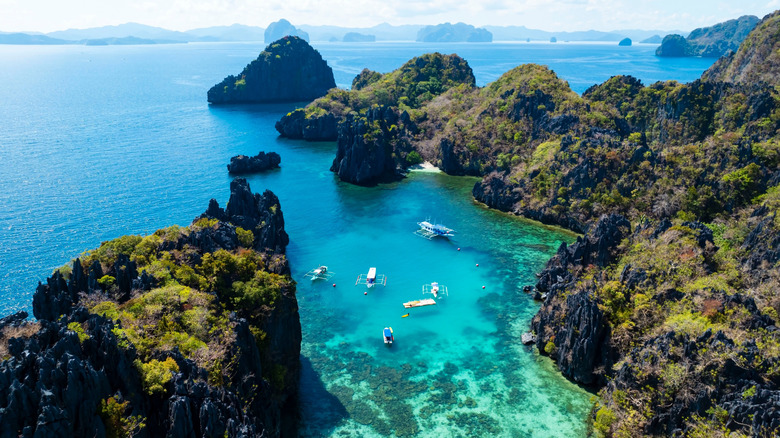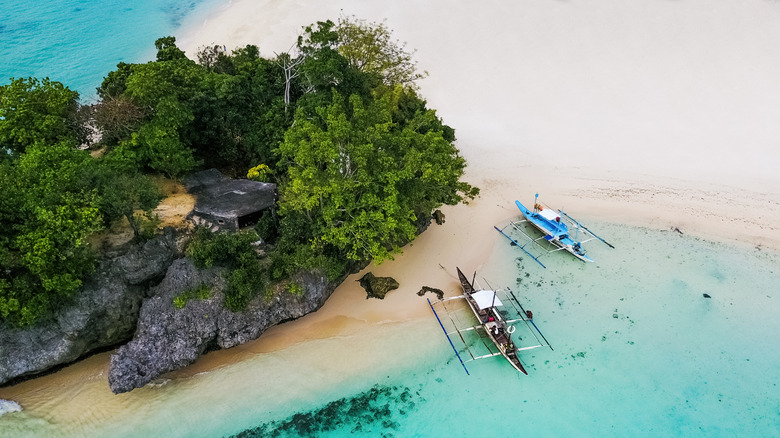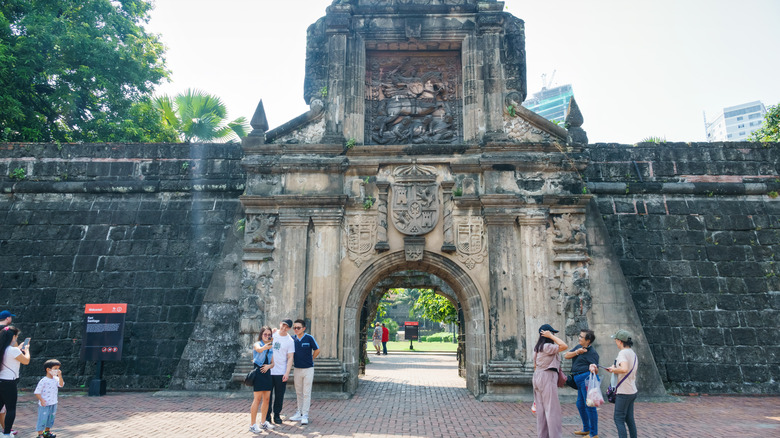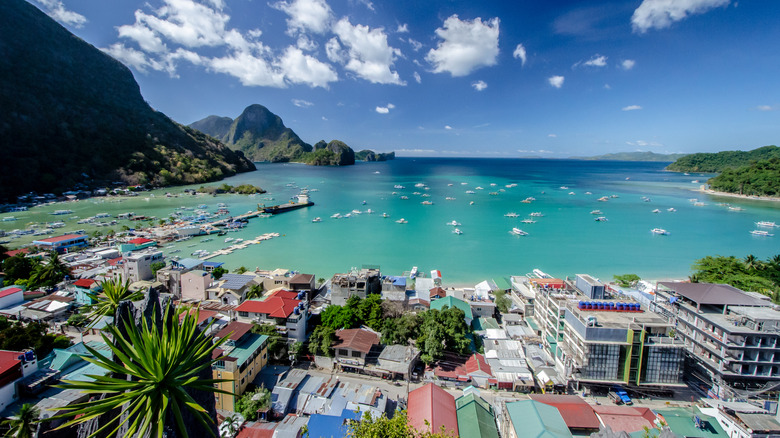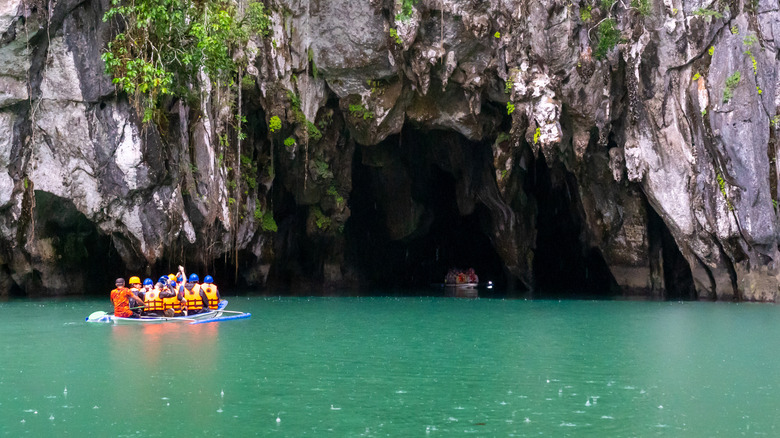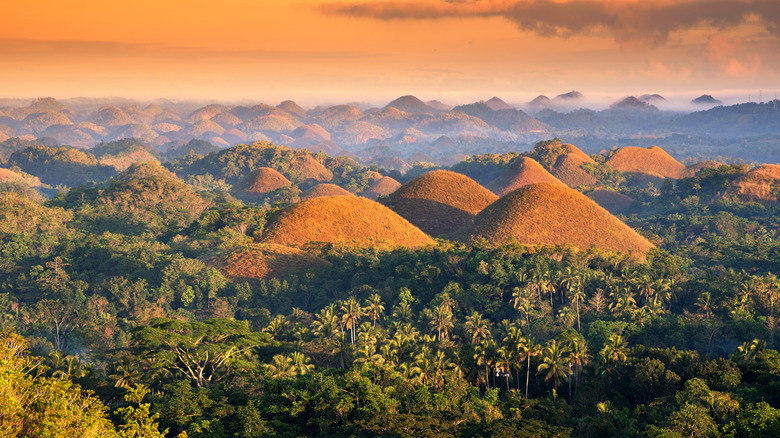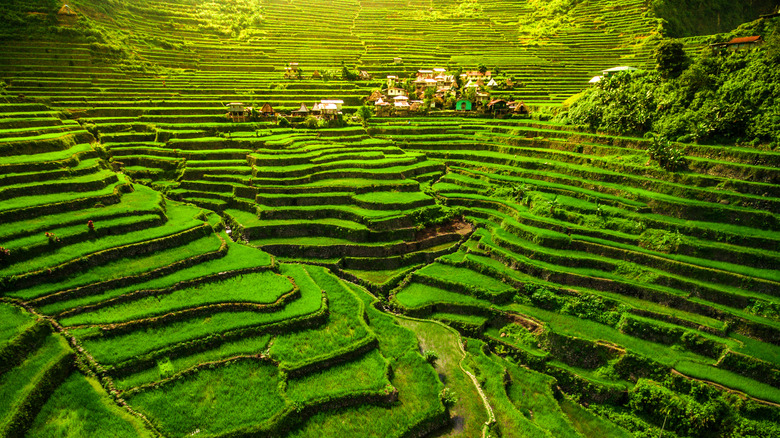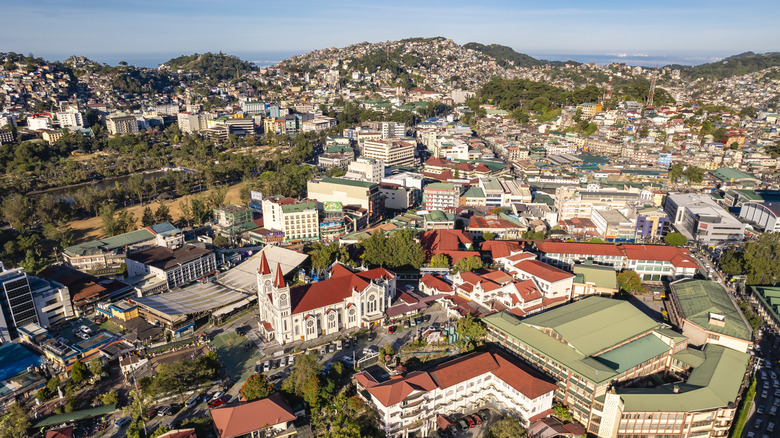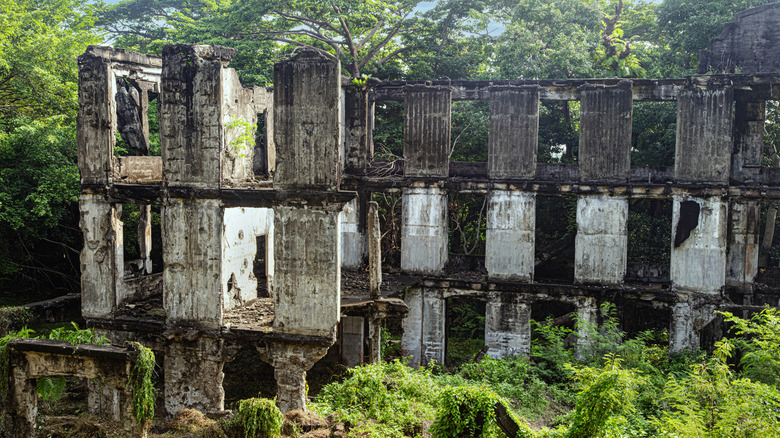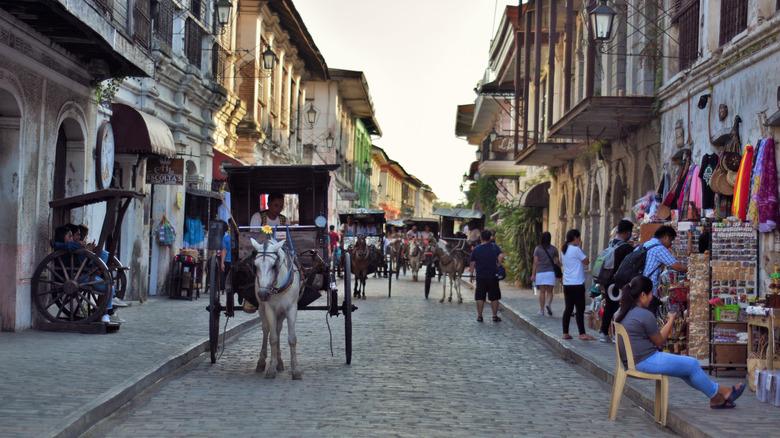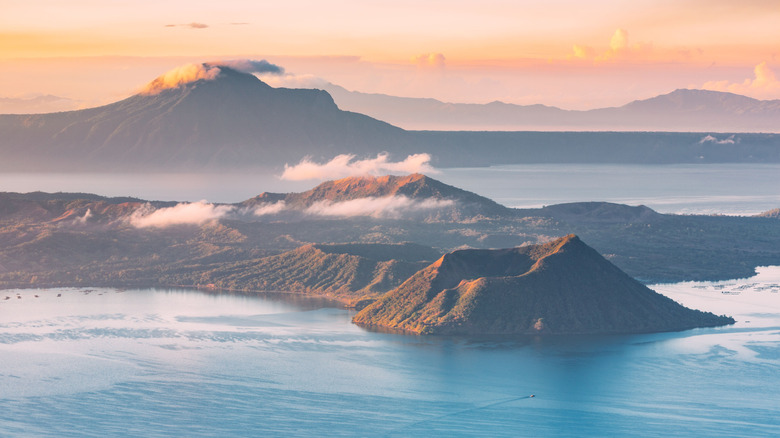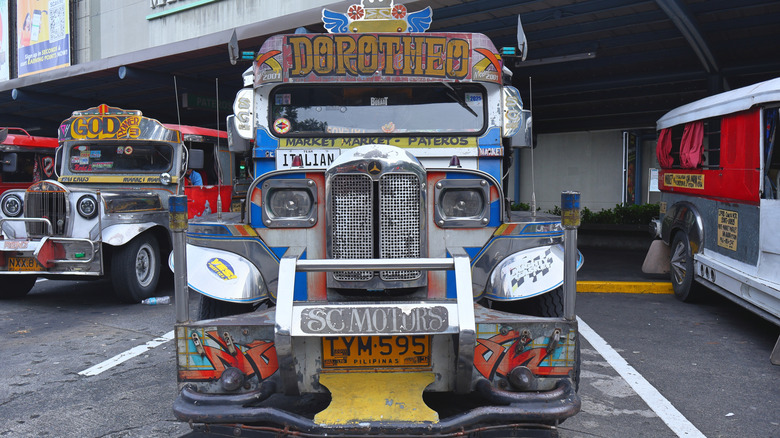The Philippines' 10 Best Tourist Attractions For A Fun Getaway
Located in the Pacific Ocean, the Philippines is an island nation brimming with stunning mountains, pristine beaches, and diversity — the archipelago is home to nearly 200 ethnolinguistic groups. Whether you're looking for resorts, artistic enclaves, bustling nightlife, or one of the world's clearest lakes with epic rock formations, there's no shortage of incredible places to visit. The country is made up of more than 7,600 islands, only about a third of which are inhabited. It's even home to what's been named Asia's best beach in 2025, a secluded slice of paradise with limestone cliffs and turquoise waters.
One thing to keep in mind is the time of year that's best for a visit. The Philippines experiences a substantial rainy season, which runs approximately from June to November. Tropical storms, including large cyclones or typhoons, bring intense winds and flash floods, which are becoming more frequent due to climate change. While cyclones can happen at any time, they typically impact the eastern side of the country, and there's always plenty of warning. Dry season starts in November and continues through April, with December through February being preferred by travelers who want to avoid the hotter and more humid months — although you may find it more crowded, and prices will reflect demand. March through May is usually the sunniest time of the year, ideal for soaking up the rays, but it's also when it's hottest. To make planning easier, here are 10 fantastic places to check out around this stunning archipelago.
Soak up rays on Boracay's beaches
A resort island located north of the city of Malay in the province of Aklan, Boracay is renowned for some of the Philippines' most glorious beaches. The glistening White Beach, aptly named for its pristine sand, is among the area's top destinations. It's become increasingly popular as an attraction for dining and scenic sunset cruises, so it can sometimes get crowded. It actually closed in 2018 in an effort to stave off overdevelopment, as it had gained a reputation as a beautiful location ruined by overtourism. Another popular spot, north of White Beach's hubbub, is Puka Shell Beach, which is the second-largest beach on Boracay. Other smaller, quieter gems on the eastern side of the island include Boracay Newcoast and Tambisaan Beach, the latter of which visitors have praised as a great spot for snorkeling. If you plan to swim, note that the water may be tinged green during algae season from February to May, which might be unnerving to some but is completely harmless.
Boracay is a top destination spot for all-inclusive beach resorts, mostly located on the west side of the island, like Shangri-La, Mövenpick Resort & Spa, and Discovery Boracay. Aside from 4- and 5-star resorts, it's also a great spot to find a bed on the cheap if spending all your time at the beach is what you're really here for. Fun and budget-friendly hostels like Chill Out Hostel, Frendz Resort & Hostel, and Happiness Hostel offer a night's sleep for often only around $20. When you're ready for some beachside eats, head to Cha Cha's Beach Cafe.
Delve into history in Manila
Located in southern Luzon, the largest and most populous island in the Philippines, Manila is the nation's capital and often the first port of call for international travelers flying into the country. There's no shortage of museums, parks, food, history, and other cultural treasures to enjoy. History buffs will find a guided tour that includes Intramuros to be a real treat. Comprising Manila's historic Old Town, Intramuros is a walled city constructed more than 400 years ago when Spanish colonial forces controlled the city. Meaning "within the walls," Intramuros is a remarkable fortification complex that contains cannons, bulwarks, moats, and centuries-old stone carvings. Intramuros encompasses Fort Santiago, which is recognized as a National Shrine, National Monument, and National Cultural Treasure.
A lovely place to take a stroll, relax, and view the skyline is in the city's most prominent green space, Rizal Park. Then, head to Binondo Chinatown — the oldest Chinatown in the world — which is a haven for foodies. Or, if you fancy learning about Filipino arts and culture, don't miss a stop at the National Museum Complex. Another very local way to see the sights is to hop aboard a Jeepney, the Philippines' most popular form of public transportation, which are often elaborately decorated from nose to tail. It's a quirky form of public transportation you don't want to skip in this island country.
Soak up the sun and explore lagoons, El Nido
The northern tip of the 250-mile-long Palawan Island features some of the Philippines' dreamiest and most postcard-worthy beaches and lagoons. One of the most popular spots is El Nido, a sought-after tourist town where the ultimate tropical paradise awaits, which provides a great base for exploring the area's islets, limestone cliffs, secluded lagoons, and stretches of powdery sand. As you can imagine, this watery paradise is a perfect place to head out on an island boat tour, and many include convenient pick-up and drop-off in El Nido before heading out on an excursion into Bacuit Bay. A couple of must-see stops on your itinerary should be both Big Lagoon and Small Lagoon, which are surrounded by dramatic rock faces and lush greenery — perfect for exploring in a kayak.
If heading straight to the beach is your top priority, Las Cabanas Beach is a favorite among visitors, especially as a spot to catch the sunset. There are plenty of options for lodging, but not many sprawling, all-inclusive resorts. H Hotel El Nido offers spectacular views and is vegan-friendly, while on the most luxurious end of the scale, the distinctive Pangulasian eco-resort offers pristine, secluded villas right on the water. Plenty of wallet-friendly options abound, too, with small resorts, vacation rentals, and hostels that stretch your peso.
Tour the Underground River, Puerto Princesa
About a five-hour drive south of El Nido, on Palawan Island, sits Puerto Princesa, the island's largest city. The area's waters are perfect for island-hopping, swimming, and snorkeling. And the aqueous wonders certainly don't end there. About an hour-and-a-half drive north, near Sabang, is the area's famous Subterranean River National Park. It's a designated UNESCO World Heritage Site and one of the most impressively long underground rivers in the world. The remarkable karst landscape features steep cliffs and deep caves that are navigable by paddle boat. With a permit secured a minimum of two days in advance, you can explore more than two and a half miles of the underground river, which is just a bit over five miles long in its entirety.
While numerous group tours visit the Underground River daily, many leaving from El Nido or Puerto Princesa, the best way to visit — if you have the time — is on a self-guided tour. You'll just want to be sure to get a visitor's permit ahead of time from either the Subterranean National Park Office in Puerto Princesa or from a tour operator. You may be able to try your luck at the boat dock in Sabang if there are still spots remaining. The park limits visitor numbers to 1,200 per day, so when it comes to accessing this one specific attraction, you might run into some congestion. In the meantime, keep an eye out for wildlife like macaque monkeys, monitor lizards, and bats. The park is also home to a whopping 252 species of birds.
See the sunset over the Chocolate Hills, Bohol
Across the island of Bohol lies a series of small mountains that range from about 100 to a bit over 300 feet tall. If that were all, they'd be relatively unremarkable, but what this region lacks in height, it makes up for in astonishing number. The more than 1,200 conical Chocolate Hills of Bohol comprise a national geological monument in the Philippines. It's estimated that there could be up to 1,776 of these wonders within a 20-square-mile area. The hills are covered in grass, so their soft appearance glows green during rainy season and turns golden-brown during the dry season. The latter color is where the hills get their name, although American tourists might also appreciate the coincidental resemblance to a favorite candy, Hershey's Kisses.
Views of the Chocolate Hills can be enjoyed from two observation decks. One is part of the Chocolate Hills Complex, which includes a resort. The other is Sagbayan Peak, which has places to eat and drink while you take in the views. A popular way to see the area is via a Bohol countryside tour, which often combines stops at the Loboc River and the nearby Tarsier Sanctuary, where you can observe these tiny, wide-eyed primates and learn about conserving their natural habitat. Enjoy the views with the addition of thrills at Chocolate Hills Adventure Park, where you can climb among the trees and go ziplining.
Hike around the Batad Rice Terraces
In north-central Luzon, amid verdant mountains, you'll find a UNESCO World Heritage-designated area known for its rice terraces. For two millennia, farmers have cultivated rice in terraced paddies in villages surrounding Banaue and Ifugao that gracefully mirror the topography. In practices that have been handed down through the generations over the centuries, these features of the Cordillera Mountains are a rare and distinctive glimpse of a timeless agricultural tradition in which remote communities live in harmony with the land.
The Banaue-Ifugao area is an amazing place to hike, and many tours are designed around scenic walks so that you can experience the landscape firsthand, including optional stays in local villages. A two-day tour provided by Uncharted Philippines Adventure Travel and Day Tours, for example, offers a weekend hiking trip for small groups that originates in Manila for easy connections. Make a point to visit both the Batad and Bangaan Rice Terraces, where you can take in dramatic views of meticulously hand-worked mountainsides. To really get a sense of the scope of this place, a panoramic view from above is second to none. One popular route is a nearly three-mile challenging loop hike to see the Batad terraces from a total elevation gain of 1,220 feet. The town of Banaue, home to its own rice terraces, is also a sight to behold.
Escape the heat in Baguio
Tucked away in northern Luzon, the city of Bagiuo is a beloved retreat for tourists and locals alike. About four hours north of Manila by car, it's also reachable by bus in around six to seven hours — it's a wonderful destination for either a weekend jaunt or as a base for exploring other areas in the Cordillera Mountains. As a UNESCO Creative City, Baguio is recognized for its diverse and multicultural creativity, from time-honored Indigenous crafts to contemporary art forms. Because it's situated at around 4,600 feet in elevation, it's cooler than some of the lowland areas and is perfect for an escape from the heat. It's known fondly as the "Summer Capital of the Philippines," and the city brims with galleries, shops, green spaces, and amazing places to eat.
Burnham Park, for one, spans more than 80 acres with something for everyone, including rowboat rentals for a picturesque paddle in the Burnham Lagoon. Study an array of flora at the Bagiuo Botanical Garden, see phenomenal Indigenous craftsmanship at Tam-Awan Village — which is also responsible for the colorful artwork on the hillside homes of Stobosa — and head to Mines View Park to take in the stunning mountain vista. Bagiuo is also a gateway to Mt. Pulag National Park, which is about a two-and-a-half-hour drive northeast of the city. Mt. Pulag is the tallest mountain in Luzon (and the second tallest in the country) and offers astonishing views from its summit.
Explore military history on Corregidor Island
As Japanese forces advanced on the Philippines during World War II, one particular strategic spot became the locus of a number of pivotal battles: Corregidor Island. Situated in Manila Bay, this historic island provided a protective stronghold during the war. But in spring 1942, after sustained bombardment, Filipino and allied American troops could no longer defend the bay. In February 1945, American forces began a mission to regain control of the Japanese garrison on Corregidor, and by the end of the month, the island was in American hands — although not without around 4,500 Japanese casualties and more than 1,000 Filipino and American lives lost.
Today, Corregidor Island is a testament to this critical moment during the Pacific War, and it serves as a memorial and museum that honors the Filipino and American soldiers who gave their lives. The Malinta Tunnel, an 820-foot-long bunker, contains General MacArthur's headquarters, some parts of which contain old typewriters and ephemera left in place since the war. Trace the history of the battles at the Pacific War Memorial Museum, tour a number of monuments, and take in the Mile-Long Barracks. Full-day tours from Manila can navigate to Corregidor Island, but they can be a little pricey at around $400 per person.
Tour colorful Vigan City
Another UNESCO-designated gem in the Philippines is the city of Vigan. Known for its Spanish colonial architecture – the best preserved in Asia – this area provides a glimpse into the Philippines' colonial past. In its unique way, it's an atmospheric and charming coastal city that feels like traveling back in time to the European Renaissance, which has seen a substantial rise in tourism over the past few decades. Cobblestone streets are lined with distinctive "báhay na bató" stone buildings, which combine colonial and indigenous architectural influences.
You'll find two main squares in the Old Town — Plaza Salcedo and Plaza Burgos — with the prominent St. Paul's Cathedral in between. This is the kind of place that's eminently walkable, and its gridded layout makes it difficult to get lost. Take in the ornate church, beautiful fountains, and picturesque homes along quaint streets on a relaxing afternoon stroll. Dig into a local delicacy known as bagnet, or pork belly, then settle into one of numerous wallet-friendly guest houses or small hotels, like Villa Angela Heritage House.
See Taal Volcano from Tagaytay
Taal Volcano is a highly active volcano that has seen a lot of recent eruption activity, making it the sort of place that it's smart not to get too close to when it's acting up, but one that can provide amazing views from a safe distance. If it's on the quieter side, you can take a cruise around Lake Taal, or you can hop on a boat tour to see the unique geological formation from the water. Tours like those offered by Yolo Travel Philippines will take visitors around Lake Taal for great views of the volcano, then pair a jaunt to secluded waterfalls at Malagaslas Spring.
Don't miss a visit to Tagaytay, where you can see the volcano from afar. Dig into authentic local cuisine at Siglo Modern Filipino or soak up the view from a patio table at Rosario, Pamanang Panlasa. Many restaurants offer spectacular views over the crater lake, and you can even observe it from the roof deck of Museo Orlina, a small museum dedicated to the contemporary work of local glass artist Ramon Orlina. Wander through the museum's sculpture garden with its four levels of displays. And for a trek to an unparalleled view, head to Peoples Park in the Sky on Mount Sungay, which offers panoramic views over the water and volcano from a unique site that was originally begun as a mansion but was never finished. It's quirky with unbeatable views.
Methodology
To round up the top 10 attractions and destinations in the Philippines, we researched tourism sites like GuidetothePhilippines.ph, Tourism.gov.ph, Aklan.gov.ph, and FabulousPhilippines.com, along with specific location information provided by VisitFortSantiago.com, Vigan.ph, and others. Some data and information about history, science, and events was sourced from organizations like UNESCO, the U.S. Army Airborne & Special Operations Museum, the National Integrated Climate Change Databased & Information Exchange System, National-Parks.org, and VolcanoDiscovery.com. For the most up-to-date information about experiences like tours and resorts, we consulted specific businesses' websites and relied on honest reviews, discussions, and ratings from visitors on sites like Tripadvisor, Alltrails, Reddit, and Google.
